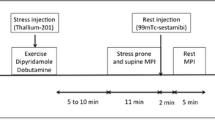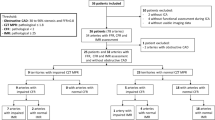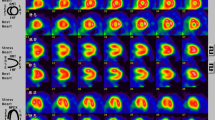Abstract
Background
We assessed coronary flow reserve (CFR) by sestamibi imaging in patients with type 2 diabetes without coronary artery disease and normal coronary vessels.
Methods and Results
Dipyridamole/rest technetium 99m sestamibi imaging was performed in 33 patients with type 2 diabetes without a history of coronary artery disease and normal coronary vessels at angiography and in 12 control subjects. Myocardial blood flow (MBF) was estimated by measuring first-transit counts in the pulmonary artery and myocardial counts from tomographic images. Estimated CFR was expressed as the ratio of stress MBF to rest MBF. Rest MBF and CFR were corrected for rate-pressure product and expressed as normalized MBF and normalized CFR. At rest, estimated MBF and normalized MBF were not different in control subjects versus patients (0.98±0.4 counts·pixel−1·s−1 vs 1.42±0.9 counts·pixel−1·s−1 and 1.14±0.5 counts·pixel−1·s−1 vs 1.61±0.9 counts·pixel−1·s−1, respectively). Conversely, stress MBF was higher in control subjects than in patients (2.34±0.8 counts·pixel−1·s−1 vs 1.55±0.8 counts·pixel−1·s−1, P<.01). Thus estimated CFR was higher in control subjects than in patients (2.40±0.3 vs 1.36±0.8, P<.0001). After correction for the rate-pressure product, normalized CFR was still higher in control subjects than in patients (2.10±0.5 vs 1.28±0.8, P<.001).
Conclusions
Sestamibi imaging may detect impaired coronary vascular function in response to dipyridamole in type 2 diabetic patients withou a history of coronary artery disease and with normal coronary arteries.
Similar content being viewed by others
References
Grundy SM, Benjamin IJ, Burke GL, Chait A, Eckel RH, Howard BV, et al. Diabetes and cardiovascular disease, a statement for healthcare professionals from the American Heart Association. Circulation 1999;100:1134–46.
Laakso M. Glycemic control and the risk for coronary heart disease in patients with non-insulin-dependent diabetes mellitus. The Finnish studies. Ann Intern Med 1996;124:127–30.
Nitenberg A, Valensi P, Sachs R, Dalim M, Aptecar E, Attali JR. Impairment of coronary vascular reserve and Ach-induced coronary vasodilatation in diabetic patients with angiographically normal coronary arteries and normal ventricular systolic function. Diabetes 1993;32:1017–23.
Nahser PJ, Brown RE, Oskarsson H, Winnifold MD, Rossen JD. Maximal coronary flow reserve and metabolic coronary vasodilatation in patients with diabetes mellitus. Circulation 1995;91:635–40.
Mintz GS, Painter JA, Pichard AD, Kent KM, Satler LF, Popma JJ, et al. Atherosclerosis in angiographically “normal” coronary artery reference segments: an intravascular ultrasound study with clinical correlations. J Am Coll Cardiol 1995;25:1479–85.
Yarom R, Zirkin H, Stammler G, Rose AG. Human coronary microvessels in diabetes and ischaemia. Morphometric study of autopsy material. J Pathol 1992;166:265–70.
Meyer C, Schwaiger M. Myocardial blood flow and glucose metabolism in diabetes mellitus. Am J Cardiol 1997;80:94A-101A.
Di Carli MF, Janisse J, Grunberger G, Ager J. Role of chronic hyperglycemia in the pathogenesis of coronary microvascular dysfunction in diabetes. J Am Coll Cardiol 2003;41:1387–93.
Pitkanen OP, Nuutila P, Raitakari OT, Ronnemaa T, Koskinen PJ, Iida H, et al. Coronary flow reserve is reduced in young men with IDDM. Diabetes 1998;47:248–54.
Srinivasan M, Herrero P, McGill JB, Bennik J, Heere B, Lesniak D, et al. The effects of plasma insulin and glucose on myocardial blood flow in patients with type 1 diabetes mellitus. J Am Coll Cardiol 2005;46:42–8.
Nahser PJ, Brown RE, Oskarsson H, Winniford MD, Rossen JD. Maximal coronary flow reserve and metabolic coronary vasodilatation in patients with diabetes mellitus. Circulation 1995;91:635–40.
Yokoyama I, Yonekura K, Ohtake T, Yang W, Shin WS, Yamada N, et al. Coronary microangiopathy in type 2 diabetic patients: relation to glycemic control, sex, and microvascular angina rather than to coronary artery disease. J Nucl Med 2000;41:978–85.
Bergmann SR, Fox KA, Rand AL, McElvany KD, Welch MJ, Markham J, et al. Quantification of regional myocardial blood flow in vivo with H2-15O. Circulation 1984;70:724–33.
Araujo LI, Lammertsma AA, Rhodes CG, McFalls EO, Iida H, Rechavia E, et al. Noninvasive quantification of regional myocardial blood flow in coronary artery disease with oxygen-15-labeled carbon dioxide inhalation and positron emission tomography. Circulation 1991;83:875–85.
Hutchins G, Schwaiger M, Rosenspire KC, Krivokapitch J, Schelbert HR, Kuhl DE. Noninvasive quantification of regional myocardial blood flow with N-13 ammonia and dynamic positron emission tomographic imaging. J Am Coll Cardiol 1990;15:1032–42.
Schelbert HR, Phelps ME, Huang SC, MacDonald NS, Hansen H, Selin C, et al. N-13 ammonia as an indicator of myocardial blood flow. Circulation 1981;63:1259–72.
Sugihara H, Yonekura Y, Kataoka K, Fukai D, Kitamura N, Taniguchi Y. Estimation of coronary flow reserve with the use of dynamic planar and SPECT images of Tc-99m tetrofosmin. J Nucl Cardiol 2001;8:575–9.
Storto G, Cirillo P, Vicario ML, Pellegrino T, Sorrentino AR, Petretta M, et al. Estimation of coronary flow reserve by Tc-99m sestamibi imaging in patients with coronary artery disease: comparison with the results of intracoronary Doppler technique. J Nucl Cardiol 2004;11:682–8.
Devereux RB, Reichek N. Echocardiographic determination of left ventricular mass in man. Anatomic validation of the method. Circulation 1977;55:613–8.
Vicario ML, Cirillo L, Storto G, Pellegrino T, Ragone N, Fontanella L, et al. Influence of risk factors on coronary flow reserve in patients with 1-vessel coronary artery disease. J Nucl Med 2005; 46:1438–43.
Acampa W, Spinelli L, Petretta M, De Lauro F, Ibello F, Cuocolo A. Prognostic value of myocardial ischemia in patients with uncomplicated acute myocardial infarction: direct comparison of stress echocardiography and myocardial perfusion imaging. J Nucl Med 2005;46:417–23.
Sundell J, Janatuinen T, Ronnemaa T, Raitakari OT, Toikka J, Nuutila P, et al. Diabetic background retinopathy is associated with impaired coronary vasoreactivity in people with Type 1 diabetes. Diabetologia 2004;47:725–31.
de Silva R, Camici PG. Role of positron emission tomography in the investigation of human coronary circulatory function. Cardiovasc Res 1994;28:1595–612.
Taki J, Fujino S, Nakajima K, Matsunari I, Okazaki H, Saga T, et al. Tc-99m sestamibi retention characteristics during pharmacological hyperemia in human myocardium: comparison with coronary flow reserve measured by Doppler flowire. J Nucl Med 2001;42:1457–63.
Ito Y, Katoh C, Noriyasu K, Kuge Y, Furuyama H, Morita K, et al. Estimation of myocardial blood flow and myocardial flow reserve by 99mTc-sestamibi imaging: comparison with the results of O-15 H2O PET. Eur J Nucl Med Mol Imaging 2003;30:281–7.
Smits P, Williams SB, Lipson DE, Banitt P, Rongen GA, Creager MA. Endothelial release of nitric oxide contributes to the vasodilator effect of adenosine in humans. Circulation 1995;92: 2135–41.
Buus NH, Bottcher M, Hermansen F, Sander M, Nielsen TT, Mulvany MJ. Influence of nitric oxide synthase and adrenergic inhibition on adenosine-induced myocardial hyperemia. Circulation 2001;104:2305–10.
Czernin J, Porenta G, Brunken R, Krivokapich J, Chen K, Bennett R, et al. Influence of age and hemodynamics on myocardial blood flow and flow reserve. Circulation 1993;88:62–9.
Author information
Authors and Affiliations
Corresponding author
Rights and permissions
About this article
Cite this article
Storto, G., Pellegrino, T., Sorrentino, A.R. et al. Estimation of coronary flow reserve by sestamibi imaging in type 2 diabetic patients with normal coronary arteries. J Nucl Cardiol 14, 194–199 (2007). https://doi.org/10.1016/j.nuclcard.2006.12.327
Received:
Accepted:
Issue Date:
DOI: https://doi.org/10.1016/j.nuclcard.2006.12.327




